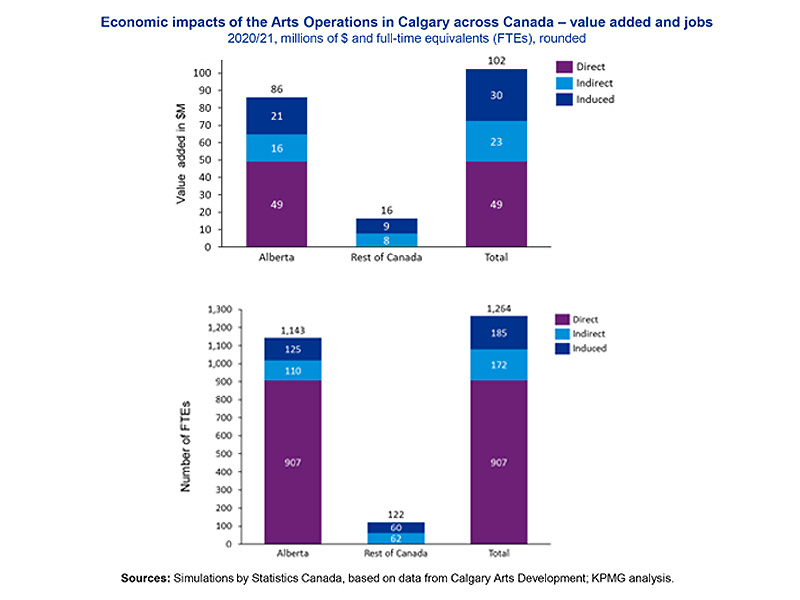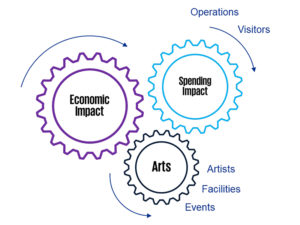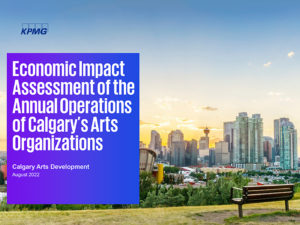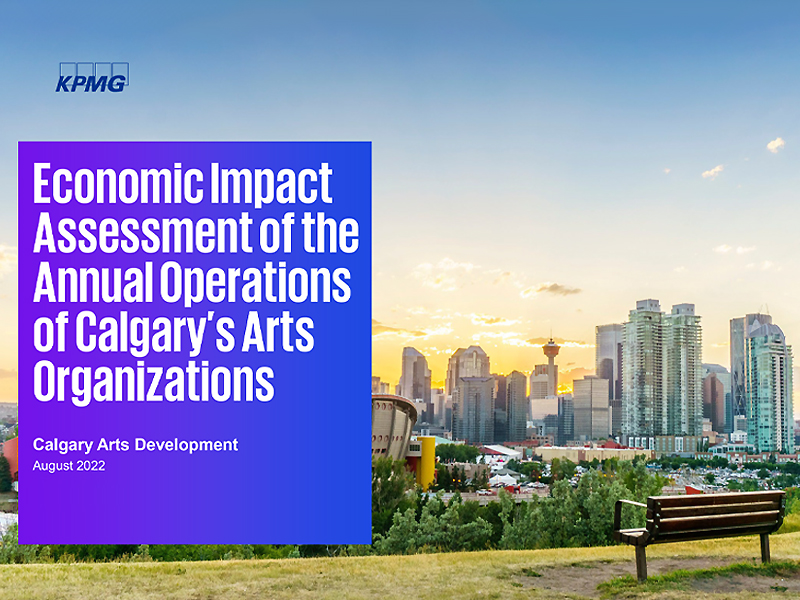2020 Economic Impact Assessment of Calgary Arts Development Grant Recipients
In 2022, Calgary Arts Development contracted KPMG, a leading global professional services firm, to independently conduct a revised economic impact assessment of Calgary arts organizations that receive Calgary Arts Development operating grant funding. The assessment measured recurring economic impacts resulting from the collective operating expenditures of these 166 operating grant recipients. This is an update to the 2018 Economic Impact Assessment.
The economic impacts relate to the direct and indirect impacts from the injection of dollars that result from the operating expenditures of these collective arts organizations. Types of operating expenditures include: salaries and benefits, production and equipment, fees paid to artists, rent and facility costs, marketing and communications, supplies, administration and other costs.
This study focuses on quantifying four specific dimensions of economic impact: value-added GDP, labour income, employment, and government revenue.
In the fiscal year beginning 2020, arts operations in Calgary receiving operating grant funding generated:
- $102.4 million in value-added or GDP activity in Canada, with the large majority ($86 million) occurring in Alberta.
- 1,264 full-time equivalent (FTE) jobs created or sustained across Canada.
- $19.2 million in gross government revenues accrued across Canada, mostly ($16 million) in Alberta.
Even during COVID-19, Calgary’s arts sector has generated more than $100 million in value-added (GDP) and sustained over 1,200 jobs in the fiscal year beginning 2020.
The activities of arts organizations generate significant annual economic impacts, primarily through their expenditures on goods, services and labour that inject new dollars into the provincial economy. The operating grant clients generated an estimated $102 million of value-added (GDP) in Canada.
Most of the GDP impact generated occurred in Alberta ($86 million), while the impact in other provinces combined is $16 million. It is expected that most of the direct impacts of arts operations (consisting of salaries) will remain within the Calgary area. Calgary specifically retained an estimated $72.1 million.
1,264 full-time equivalent (FTE) jobs sustained across Canada
More than 1,100 jobs are sustained in Alberta, while 122 indirect or induced jobs are supported in the rest of Canada.

$19 million in estimated taxes across government levels in Canada
Government revenues include: taxes on products such as GST, provincial sales tax except in Alberta, gas tax and other taxes; taxes on production such as capital taxes, license fees, land transfer taxes, and local real property taxes, fees and other levies; and income tax estimates on direct labour.
The majority ($15.9 million) generated in Alberta, of which:
- $1.5 million in municipal tax revenues
- $5.9 million in provincial tax revenues
- $8.4 million in federal tax revenues
An additional $3.4 million in provincial and municipal government revenues are generated indirectly outside Alberta.
The disruptive effects of COVID-19 in the Calgary arts sector
This assessment shows the disruptive effects of the COVID-19 pandemic on the arts sector. Programming cancellations impacted revenue levels (declining from $120 million in 2018 to $96 million in 2020/21), especially earned revenue.
Public sector funding available during the emergency was essential to partially offset this decline. Expenditures also fell and remaining expenses concentrated in sustaining organizations’ payrolls. As a result of lower expenditure levels, the economic impact of the industry was lower compared to a previous 2018 economic impact study by KPMG. However, this study provides evidence that the impact of operations of Calgary Arts Development clients is significant and important and should grow with the rebound of economic activity in Calgary, Alberta, and across the country.
The impact of the arts sector is multi-dimensional 
Arts and culture generate operational expenditures and draw out-of-province visitors who spend money in Calgary. This in turn produces an economic impact on the provincial and local economies. But the impact of arts organizations goes beyond this.
Arts facilities draw interest towards areas of the city and thus become a catalyst for other developments/investments. Beyond the significant economic impacts, arts contribute other intangible benefits such as showcasing the city, providing education opportunities, inspiring youth, wellness, and contributing to the quality of life and sense of community in Calgary. Arts organizations add community assets, entertainment and vibrancy to the city.
Key investments in 2020/2021
In 2021, Calgary Arts Development invested $11.6 million through more than 552 grants to organizations, individual artists and arts collectives. Of this amount, $6.7 million was invested through the Operating Grant Program benefiting 166 non-profit organizations that comprise this economic impact study. Approximately $2.1 million was invested in individuals, collectives and organizations through the project grant program.
In 2020, facing the COVID-19 emergency, approximately $1.1 million was invested through the Short-Term Relief Fund, helping 57 organizations and 133 individual artists navigate the shutdown of programming and cancellation of contracts. Calgary Arts Development invested about $2.3 million in 125 non-profit arts organizations, from the City of Calgary’s Emergency Resilience Fund.
Model Methodology
KPMG used the Statistics Canada Input/Output Model.
Statistics Canada Input/Output Model is the authoritative input/output model in Canada and has the most comprehensive sets of data available in Canada. The model is independent of any private firm and is recognized by many as the benchmark by which economic modeling is undertaken in Canada. The Statistics Canada model is updated annually.
The Statistics Canada Input/Output Model can be used for many types of industries and impacts, which makes it more flexible and also allows for comparison between studies. There are limitations in all input/output models, but Statistics Canada is the most frequently used in Canada. It is flexible, rigorous and allows for comparison between provinces and sectors.
Download the full report:

